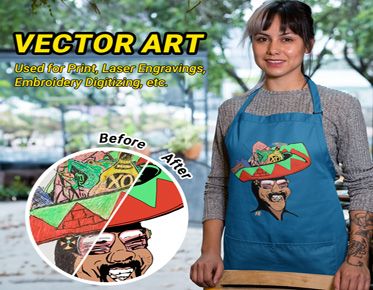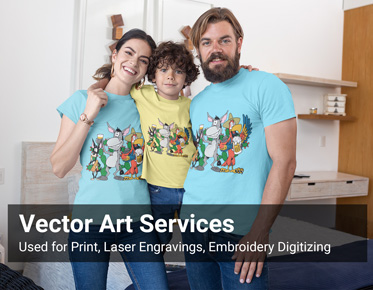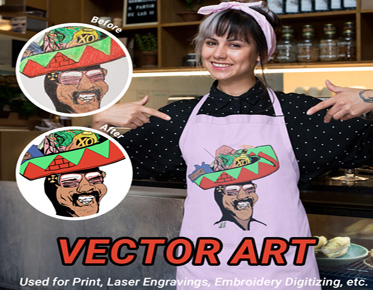All About Screen Printing Kits: Your Ultimate Handbook
Diving into the world of screen printing and
silk screening can be both exciting and a tad overwhelming. Whether you're a
budding artist, a small business owner, or a hobbyist, having the right kit is
essential to achieving those crisp, vibrant prints. Let’s explore everything
you need to know about choosing the perfect screen printing or silk screening
kit. Read here are some things that
you should know when it comes to vector logo conversion!
Understanding
Screen Printing and Silk Screening
What is Screen Printing?
Screen printing is a printing technique where ink is pushed through a
mesh stencil (or screen) to create a design on various surfaces like fabric,
paper, or plastic. It’s a popular method due to its versatility and ability to
produce high-quality, durable prints.
What is Silk Screening?
Silk screening is essentially the same as screen printing, but it
harks back to the traditional use of silk mesh for the screens. Today,
polyester is more commonly used, but the term “silk screening” is still widely
recognized and often used interchangeably with screen printing.
Why Choosing the Right Kit
Matters
Choosing the right kit can make or break your screen printing experience. The right tools ensure the precision, efficiency, and longevity of your prints. Plus, it can save you time, frustration, and money in the long run.
Key
Components of a Screen Printing/Silk Screening Kit
Screens: The Heart of the Kit
Screens are the core of any printing kit. They come in various mesh
counts, each suited for different levels of detail and ink thickness. The
choice of screen can significantly impact the quality of your print.
Squeegees: Essential Tools for
Perfect Prints
A good squeegee is crucial for spreading the ink evenly across the
screen. They come in different sizes and shapes, tailored to various printing
needs. A quality squeegee ensures a smooth, consistent application of ink.
Inks and Emulsions: Getting the
Colors Right
Inks and emulsions are the lifeblood of screen printing. Plastisol
inks are great for textiles, offering vibrant colors and durability.
Water-based inks are eco-friendly and suitable for a softer finish. Emulsions
are used to create the stencil on your screen and vary in sensitivity and
application methods.
Exposure Units: Bringing Your
Designs to Life
Exposure units are used to harden the emulsion on your screen,
creating a stencil. They range from simple light sources to advanced units with
vacuum frames. Proper exposure is key to a sharp, detailed stencil.
Drying Racks: Ensuring Quality
and Longevity
Drying racks are essential for curing your prints. Proper drying ensures that your prints don’t smudge and that the ink sets correctly, providing longevity and durability.
Types
of Kits Available
Starter Kits: For the Newbies
Starter kits are designed for beginners, offering basic tools and
materials to get you started. They usually include a screen, squeegee, inks,
and an exposure unit. These kits are perfect for learning the basics without a
huge investment.
Intermediate Kits: Stepping Up
Your Game
Intermediate kits offer more advanced tools and additional supplies.
They’re ideal for those who have some experience and want to expand their
capabilities. These kits often include multiple screens, a better exposure
unit, and a wider range of inks.
Professional Kits: For the Pros
Professional kits are top-of-the-line, providing high-quality equipment and a comprehensive set of tools. They’re designed for serious printers who need reliability, efficiency, and precision for large-scale production or intricate designs.
Top
Starter Kits
Best Kits for Beginners
When starting out, it’s crucial to choose a kit that’s user-friendly
and comprehensive. Look for kits that include detailed instructions and all
necessary components to get you up and running quickly.
What to Look for in a Starter
Kit
Ensure your starter kit includes a screen, squeegee, basic inks, and
an exposure unit. A guidebook or access to online tutorials is a plus, helping
you navigate the initial learning curve.
Pros and Cons of Popular
Beginner Kits
Popular beginner kits often come at an affordable price but might lack some advanced features. However, they’re perfect for learning and experimenting without a significant upfront cost. Evaluate the durability and completeness of the kit before purchasing.
Intermediate
Kits: Taking It Up a Notch
Features of a Good Intermediate
Kit
A good intermediate kit should offer a balance of advanced features
and ease of use. Look for kits with multiple screens, higher-quality inks, and
more sophisticated exposure units.
Best Intermediate Kits on the
Market
Some of the best intermediate kits provide a broader range of tools
and supplies, allowing for more complex projects. Brands like Speedball and
Ryonet are known for their high-quality intermediate kits.
Transitioning from Beginner to
Intermediate
As you move from beginner to intermediate, focus on enhancing your skills and understanding the nuances of screen printing. Invest in better equipment and experiment with different techniques to refine your craft.
Professional
Kits: For Serious Printers
High-End Features to Look For
Professional kits should include top-tier equipment like precision
exposure units, durable screens with high mesh counts, and professional-grade
inks. These features ensure consistent, high-quality results.
Top Professional Kits You Can
Buy
Top professional kits often come from brands like Anatol and Vastex.
They provide advanced tools, comprehensive supplies, and support for
large-scale production, ensuring you have everything needed for professional-grade
prints.
Investing in a Professional Kit:
Is It Worth It?
Investing in a professional kit can be costly but is worth it if screen printing is a significant part of your business or artistic practice. The quality, efficiency, and reliability of professional kits can greatly enhance your productivity and output.
DIY
Kits vs. Pre-Assembled Kits
Advantages of DIY Kits
DIY kits offer flexibility and customization. You can choose specific
components that suit your needs and budget, allowing for a more tailored setup.
Benefits of Pre-Assembled Kits
Pre-assembled kits save time and hassle. They come with everything you
need, carefully selected to work together seamlessly. This convenience is ideal
for those who prefer a ready-to-use solution.
Which One Should You Choose?
Choose a DIY kit if you enjoy customizing and have specific requirements. Opt for a pre-assembled kit if you prefer convenience and an all-in-one solution to get started immediately.
Brand
Comparisons
Top Brands in the Screen
Printing World
Brands like Speedball, Ryonet, and Vevor are well-known for their
quality and reliability. Each brand offers a range of kits suited for different
skill levels and applications.
Comparing Features and Prices
When comparing brands, consider the features offered and their prices.
Look at the quality of screens, inks, and exposure units. Customer reviews can
provide insights into the durability and usability of the kits.
Customer Reviews and Ratings
Customer reviews are invaluable for understanding the real-world performance of a kit. Look for feedback on ease of use, quality of components, and customer support to make an informed decision.
Budget
Considerations
How Much Should You Spend?
Your budget should align with your needs and goals. Starter kits can
range from $100 to $300, while professional kits can go upwards of $1,000.
Consider what features are essential for your projects.
Finding Value for Your Money
Look for kits that strike a fair balance between quality and budget.
Sometimes, spending a bit more upfront can save you money in the long run by
avoiding replacements and upgrades.
Budget-Friendly Kits That Don’t
Skimp on Quality
Brands like Speedball offer budget-friendly kits that still deliver on quality. These kits are perfect for beginners and hobbyists who want to try screen printing without a significant financial commitment.
Specialty
Kits for Unique Projects
Kits for Multi-Color Printing
Multi-color printing kits come with multiple screens and registration
systems to align colors accurately. These kits are essential for projects that
require intricate, multi-colored designs.
Kits for Large Format Printing
Large format printing kits include larger screens and squeegees, suitable
for big projects like posters and large apparel items. These kits are perfect
for artists and businesses needing to produce sizable prints.
Specialty Kits for Unique
Materials
Specialty kits are designed for printing on non-traditional materials like glass, metal, or wood. They come with specific inks and tools to ensure the best results on these unique surfaces.
Accessories
and Add-Ons
Must-Have Accessories for Your
Kit
Essential accessories include additional screens, various squeegees,
cleaning supplies, and tape for blocking out parts of the screen. These tools
can enhance your printing process and results.
Useful Add-Ons to Enhance Your
Setup
Add-ons like flash dryers, exposure calculators, and advanced
registration systems can improve efficiency and print quality. These tools are
great for expanding your capabilities and refining your technique.
Keeping Your Kit Organized
Organization is key to maintaining an efficient workflow. Use storage solutions like shelves, drawers, and labeled containers to keep your tools and supplies tidy and easily accessible.
Maintenance
and Care
How to Maintain Your Screen
Printing Kit
Regular maintenance is essential for the longevity of your kit. Clean
your screens, squeegees, and other tools after each use. Proper storage can
prevent damage and extend the life of your equipment.
Troubleshooting Common Issues
Common issues include ink bleeding, uneven prints, and screen
clogging. Troubleshoot these problems by adjusting your technique, ensuring
proper screen tension, and using the right ink consistency.
Extending the Lifespan of Your
Equipment
Regularly inspect your equipment for wear and tear. Replace damaged components promptly and follow manufacturer guidelines for care and maintenance. Investing time in upkeep can save money and frustration.
Buying
Online vs. In-Store
Pros and Cons of Online
Purchases
Buying online offers convenience and a wide selection. However, it can
be challenging to assess the quality of products without seeing them in person.
Shipping costs and delivery times are also factors to consider.
Benefits of Buying In-Store
Buying in-store allows you to see and feel the products before
purchasing. You can get immediate advice from sales staff and avoid shipping
costs. However, options may be less extensive than at online businesses.
Tips for Finding the Best Deals
Look for seasonal sales, discounts, and bundles to get the best value.
Comparing prices across different retailers and reading customer reviews can
also help you find the best deals.
Eco-Friendly
Kits
Sustainable Options for Screen
Printing
Eco-friendly kits use sustainable materials and non-toxic inks. These
kits are designed to minimize environmental impact while still delivering
high-quality prints.
Brands Committed to the
Environment
Brands like Green Galaxy and Permaset are known for their commitment
to sustainability. They offer eco-friendly inks and materials, helping you
reduce your carbon footprint.
How to Make Your Printing More Eco-Friendly
Switch to water-based inks, recycle screens, and use biodegradable cleaning solutions. Small changes in your printing process can make a significant difference in your environmental impact. Additionally, consider using services like Eagle Digitizing for your vector art needs, ensuring high-quality designs that enhance your projects.
Choosing the right screen printing or silk screening kit can set you
on the path to creative success. Whether you're a novice or a seasoned
professional, the right tools make all the difference. Consider your needs,
budget, and goals to find the perfect kit for your projects, and utilize Eagle
Digitizing for precise and professional vector artconversion.



